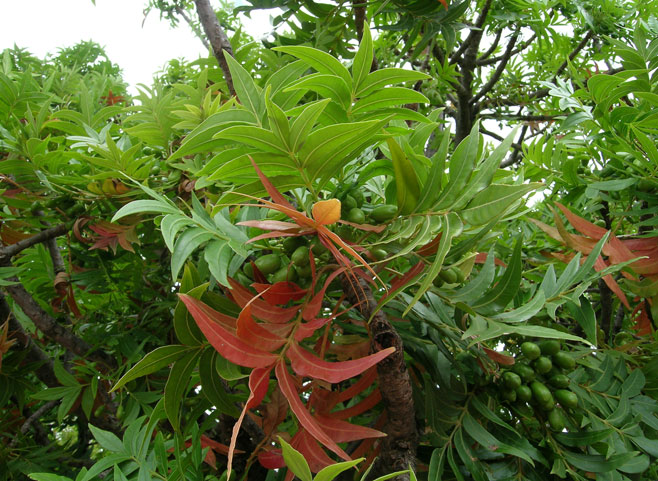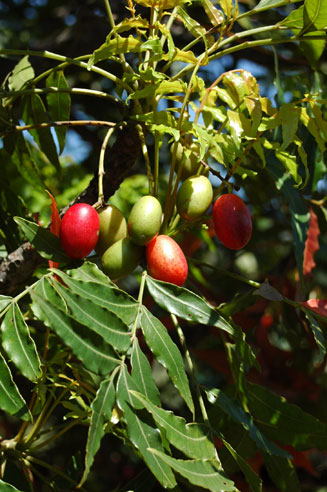Harpephyllum caffrum (Wild
plum)
Wildepruim [Afrikaans]; Mothękęlę [North Sotho]; umGwenya [Xhosa, Zulu,
Swazi]
Life
> eukaryotes >
Archaeoplastida >
Chloroplastida
>
Charophyta > Streptophytina > Plantae (land plants)
> Tracheophyta (vascular plants) > Euphyllophyta > Lignophyta (woody plants)
> Spermatophyta (seed plants) > Angiospermae (flowering
plants)
> Eudicotyledons > Core Eudicots > Rosids > Eurosid II > Order: Sapindales > Family: Anacardiaceae
 |
|
Harpephyllum caffrum, Harry Pichanick
Drive, Alexandra Park, Harare, Zimbabwe. [photo Bart Wursten ©, Flora of Zimbabwe] |
 |
|
Harpephyllum caffrum. [photo
H.G.
Robertson, Iziko ©] |
 |
 |
|
Harpephyllum caffrum. [photo John Burrows ©] |
Harpephyllum caffrum. [photo
H.G.
Robertson, Iziko ©] |
Description
A medium to large tree, growing to about 6-15 m
in height. Has compound leaves with 4-8 pairs of sickle-shaped
leaflets plus a terminal one. Leaves spirally arranged, crowded at
the end of thick branches, and leaving a scar on the branch when
they fall off. The shape of the leaf and the positioning of leaves
at the ends of branches is similar to that of
Ekebergia capensis (Cape ash) but the two species can be
distinguished by the following characters:
| Harpephyllum
caffrum |
Ekebergia capensis |
| The red fruit are
oval-shaped. |
The red fruit are round. |
| Leaves
stiff and erect. |
Leaves drooping. |
| Breaking off a leaf
produces a watery sap from where the petiole was
attached to the branch. |
No watery sap produced. |
| Tend to have the odd
red leaf. |
All leaves green. |
Distribution and habitat
Endemic to southern Africa, with a distribution
extending from the Eastern Cape, through KwaZulu-Natal and into
Swaziland, southern Mozambique, Mpumalanga and Limpopo. Occurs
mainly in coastal forest.
Ecology
- Fruit are eaten by a variety of birds including
Knysna turaco,
Purple-crested turaco,
Trumpeter hornbill, and by mammals such as
humans,
Vervet monkeys,
Chacma baboons,
fruit bats,
Bushbuck,
bushbabies and
Bushpig.
- Hollows in trunks are used for breeding by birds such as
Phoeniculus purpureus (Green wood-hoopoe).
- Leaves are eaten by the following moths and butterflies
(information from Kroon 1999): Agathodes musivalis, Anthene
definita, Bunaea alcinoe, Caligatus angasii, Colocleora
divisaria, Lymantria tacita, Rhypopteryx rhodea and
Terastia meticulosalis.
Uses
-
The wood is used for furniture, beams
and other miscellaneous uses but is not considered to be
very durable. It is pale reddish, quite heavy and polishes
well.
-
The sour-tasting fruit are eaten off
the tree by people. They are also harvested to make wine,
jams and jelly.
-
This is a very popular garden and
roadside tree in South Africa. It has been selected, along
with
Diospyros whyteana (Bladdernut) and
Markhamia
zanzibarica (Bell bean tree) as Tree of the Year for 2008 (see more
on
Department of Water Affairs and Forestry website). For information on
cultivation, see
PlantzAfrica.com.
-
The bark is used for treating skin
problems such as acne and eczema. Sprains and bone fractures
are treated with powdered burnt bark.
-
The bark is used for dying, producing a
mauve or pink colour.
Links
References
-
Joffe, P. 2001. Creative Gardening
with Indigenous Plants. A South African Guide.
Briza Publications, Pretoria.
-
Kroon, D.M. 1999. Lepidoptera of
Southern Africa - Host-plants & Other Associations.
Lepidopterists' Society of Africa, P.O. Box 477, Jukskei
Park 2153, South Africa.
-
Palgrave, K.C. & Palgrave, M.C. 2002.
Trees of Southern Africa. Struik Publishers, Cape
Town.
-
van Wyk, B.-E. & Gericke, N. 2000. People's Plants. A
Guide to Useful Plants of Southern Africa. Briza Publications,
Pretoria.
-
van Wyk, B. & van Wyk, P. 1997. Field
Guide to the Trees of Southern Africa. Struik Publishers,
Cape Town.
Text by Hamish Robertson |
